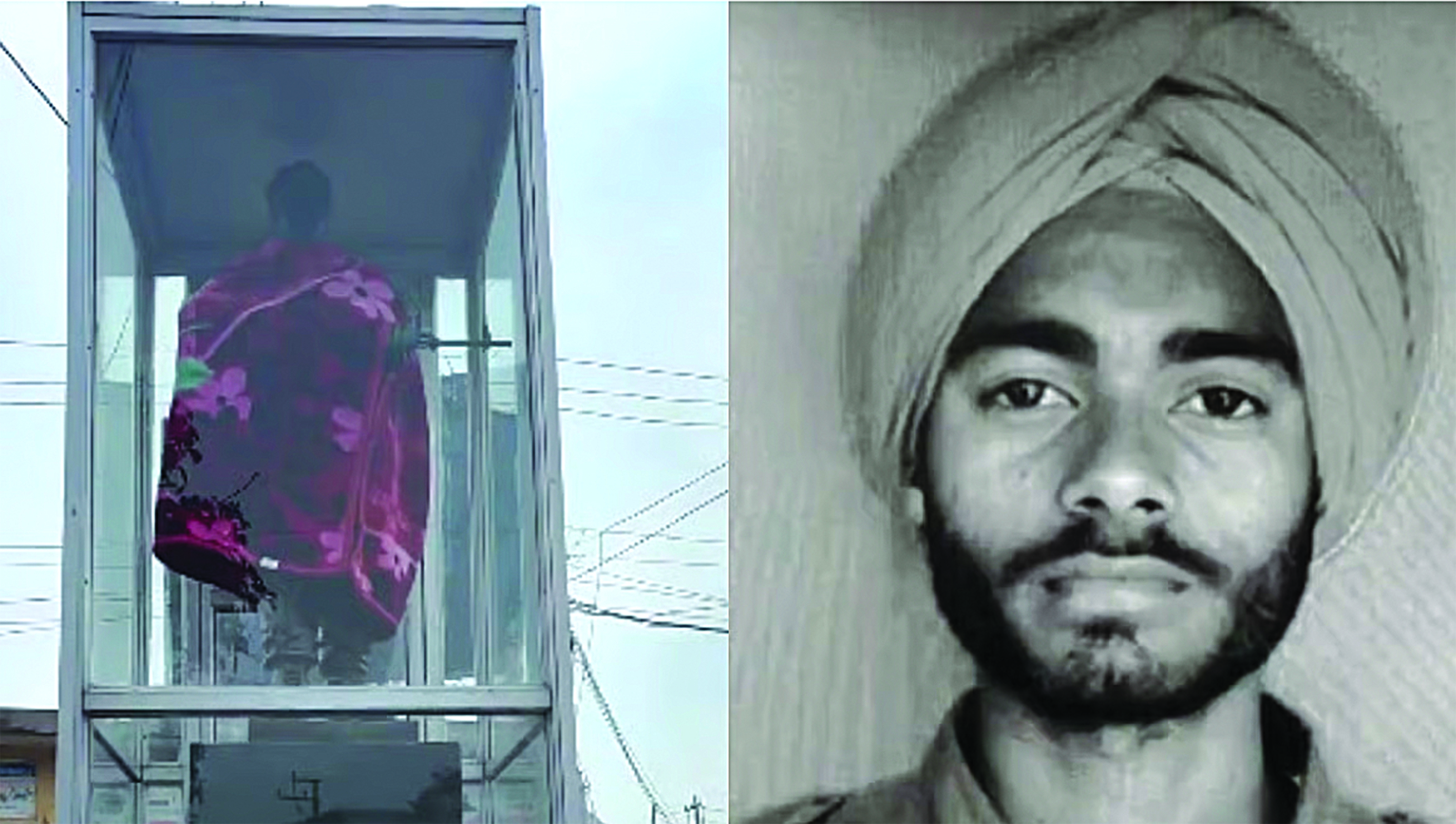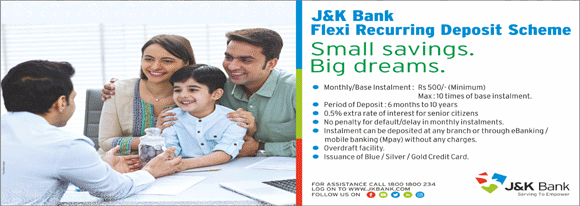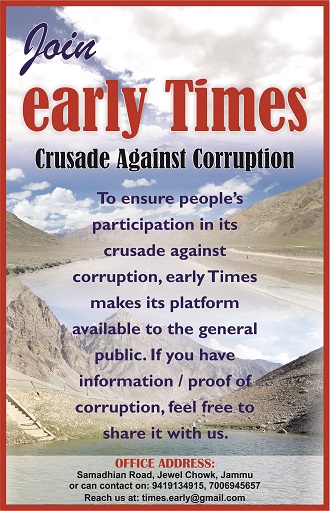TOP STORY OF THE DAY |
|
|
| Mother’s love beyond death: Blanket for a martyr’s statue in R S Pura | | |  Early Times Report
Jammu, Jan 10: A deeply moving video from the R S Pura area of Jammu has struck an emotional chord across social media, showing a grieving mother gently wrapping a blanket around the statue of her martyred son to protect him from the biting winter cold — a gesture that has left thousands of viewers in tears.
The viral clip shows Jaswant Kaur, a resident of the Ranbir Singh Pura belt, tenderly covering the statue of her son, martyr Gurnam Singh, treating it not as stone but as her living child. For Jaswant Kaur, the statue is not merely a memorial it is her son’s presence, her last connection to him after he laid down his life for the nation.
Villagers say the statue... Early Times Report
Jammu, Jan 10: A deeply moving video from the R S Pura area of Jammu has struck an emotional chord across social media, showing a grieving mother gently wrapping a blanket around the statue of her martyred son to protect him from the biting winter cold — a gesture that has left thousands of viewers in tears.
The viral clip shows Jaswant Kaur, a resident of the Ranbir Singh Pura belt, tenderly covering the statue of her son, martyr Gurnam Singh, treating it not as stone but as her living child. For Jaswant Kaur, the statue is not merely a memorial it is her son’s presence, her last connection to him after he laid down his life for the nation.
Villagers say the statue... | |
|
|
 |
|
FRONT PAGE STORIES |
|
|
| Encourage ‘swadeshi’, ‘swabhasha’: HM Shah | | | | Early Times Report
Jodhpur, Jan 10: Emphasising the need to encourage ‘Swadeshi’ and ‘Swabhasha’, Union Home Minister Amit Shah on Saturday urged people to make and use local products and converse in their mother tongue at home.
Shah said that language is key to preserving any society, culture and religion. While any language can be learnt or spoken as required to progress in the world, only Hindi and local languages must be used for conversation with children at home, as it will help strengthen their connection with their roots, he stressed.
The minister was addressing the Maheshwari Global Convention at Jodhpur, where members from the Maheshwari community have converged from various ... | |
| | | | Cong set to weed out ‘deadwood’, push youth to fore | | | | Early Times Report
Jammu, Jan 10: After completing the appointment of district presidents across all 21 organisational districts of Jammu and Kashmir, the Congress leadership is preparing for a major organisational reshuffle aimed at removing non-performing and inactive leaders and injecting fresh energy into the party ranks.
During the recently concluded exercise, the party leadership gave clear preference to younger leaders while finalising district presidents, signalling a shift towards generational change and organisational renewal.
Sources said this is only the first step of a broader overhaul planned to revive the party after its worst-ever performance in the 2024 Assembly electi... | |
| | | | Learn from history, rebuild a strong India: Ajit Doval to youth | | | | Early Times Report
Srinagar, Jan 10: National Security Advisor (NSA) Ajit Doval on Saturday urged the youth to learn from history and build a strong India in every sphere, recalling the immense sacrifices made to secure the nation’s freedom.
Speaking to a gathering of young delegates from across the country at the opening ceremony of the Viksit Bharat Young Leaders Dialogue in New Delhi, Doval traced India’s historical journey, highlighting the contributions of its people and the ethos of Indian civilisation.
“You all are lucky that you were born in an independent India. The free India we see today was not always like that. Our ancestors fought for independence for generations; they we... | |
| | | | ‘PM Modi believes societal challenges can be addressed through tech’ | | | | Early Times Report
Coimbatore (Tamil Nadu), Jan 10: Prime Minister Narendra Modi strongly believes that societal challenges can be addressed through technology, NITI Aayog Vice Chairman Suman Bery has said.
The PM has emphasised the need to align research outcomes with ‘national priorities’ and ‘public welfare’, he said.
Bery was speaking at the two day national workshop ‘Sustaining Innovation: Embedding Research and Development in State Institutions,’ convened by NITI Aayog and organised in collaboration with Amrita Vishwa Vidyapeetham and Tamil Nadu State Council for Science and Technology, here on January 9.
“The research undertaken at Amrita Vishwa Vidyapeetham is deeply rooted in... | |
| | | | Srinagar Police crack down on unregistered hotels, homestays | | | | Early Times Report
Srinagar, Jan 10: In a bid to enforce regulatory compliance and ensure safe and responsible tourism, Srinagar Police, in coordination with the Tourist Police Station Srinagar, launched a city-wide verification and inspection drive against homestays, hotels and guest houses operating without mandatory registration.
In a statement, Srinagar Police, in coordination with Tourist Police Station Srinagar, conducted a verification and inspection drive across the city to ensure compliance with statutory norms by homestays, hotels, and guest houses.
During the drive, several establishments were found operating without valid registration from the competent authorities. These i... | |
| | | | CB arrests Patwari for demanding bribe | | | | Early Times Report
Budgam, Jan 10: The Jammu and Kashmir Anti-Corruption Bureau on Saturday trapped and arrested a revenue official for demanding and accepting a bribe in Budgam district, officials said.
According to officials, ACB received a written complaint alleging that the complainant had applied before the concerned revenue authorities for issuance of a revenue extract and bank lien certificate for a property situated at Rakh Soothu BK Pora for bank guarantee purposes. The complainant alleged that the concerned Patwari of Halqa Rakh Soothu, identified as Riyaz Ahmad Khan, demanded a bribe ranging from Rs 10,000 to Rs 30,000 for preparing and providing the required documents instea... | |
| | | | Suspicious pigeon caught in Jammu | | | | Early Times Report
JAMMU, Jan 10: A suspicious pigeon was caught from a forward village near the Line of Control (LoC) in Akhnoor sector near here on Saturday, officials said.
The pale grey pigeon with two black bars on each wing is carrying red and yellow rings in legs inscribed with ‘Rehmat Sarkar’ and ‘Rizwan 2025’ followed by certain numbers was caught by a 13-year-old boy, Aryan, at Kharah village this morning, the officials said.
The wings of the pigeons were also found stamped, the officials said, adding the bird was handed over to Pallanwala police for further investigation.... | |
| | | | No extension in winter break for schools | | | | Early Times Report
Jammu, Jan 10: Amid widespread speculation on social media regarding a possible extension of winter vacations, officials clarified on Saturday that all private and government schools in the Summer Zone of Jammu will reopen as scheduled from January 12, with no further extension of the winter break.
Officials stated that the teaching faculty had already resumed their duties and were directed to attend schools on Saturday. They confirmed that teachers are present in their respective institutions, while students are expected to join classes from January 12 as per the existing academic calendar.
The clarification was issued after unverified reports circulating online cla... | |
| | | | Suspected drone found in Gorkha Nagar | | | | Early Times Report
JAMMU, Jan 10: Panic was triggered in Gorkha Nagar area of Jammu on Saturday after locals spotted an object suspected to be a drone lying near a nallah under the jurisdiction of Police Station Bagh-e-Bahu.
Official sources said, the residents immediately alerted the local police following the sighting. Acting swiftly on the information, police teams from Police Station Bagh-e-Bahu rushed to the spot and secured the suspected object.
The object has been taken into custody for detailed examination to ascertain its nature and origin. Further investigation is underway, they said.... | |
| | | | Security tightened amid surge of tourists in Bhaderwah | | | | Early Times Report
Bhaderwah/Jammu, Jan 10: Security arrangements have been strengthened across snow-bound tourist destinations in Jammu and Kashmir’s Doda following a surge of tourists over the past fortnight, officials said on Saturday.
The visible deployment of security personnel at popular high-altitude meadows, including Chattargalla (11,000 ft), Panj Nallah (10,200 ft) and Guldanda (9,555 ft) along the Bhaderwah–Pathankot highway, is aimed at boosting visitors’ confidence and maintaining strict vigilance to ensure their safety, the officials said.
Despite harsh weather conditions, the strong presence of Jammu and Kashmir Police’s Special Operations Group (SOG) and paramilitary fo... | |
| | | | JPC invites suggestions on 3 key bills | | | | Early Times Report
New Delhi, Jan 10: The Joint Parliamentary Committee constituted to examine three bills, including the Constitution (One Hundred and Thirtieth Amendment) Bill, 2025, has invited memoranda from the public and stakeholders containing views and suggestions.
The memoranda have also been invited on the Jammu and Kashmir Reorganisation (Amendment) Bill, 2025, and the Government of Union Territories (Amendment) Bill, 2025.
The Committee, chaired by Bharatiya Janata Party (BJP) MP Aparajita Sarangi, has called for written submissions from the public in general and from NGOs, experts, stakeholders and institutions in particular.
“Those interested in submitting memoranda or s... | |
| | | | Kashmir shivers as night temperatures dip further | | | | Early Times Report
SRINAGAR, Jan 10: Temperatures dipped further across the Kashmir Valley, with Shopian recording a low of minus 8.2 degrees Celsius, and clear skies leading to the freezing of parts of the Dal Lake and other water bodies during the ongoing ‘Chilla-i-Kalan’, officials said. Srinagar recorded a minimum temperature of minus 5.7 degrees Celsius on Friday night, up from the previous night’s minus 6.0 degrees Celsius, which was the coldest in the city so far this season, they said. The minimum temperature in the city was 3.8 degrees below the seasonal average.
The bone-chilling cold conditions led to the freezing of the parts of several water bodies, including the interiors ... | |
| | |
|
|
|
| |
|
|
|
|
|
|
|
|
|
|
|
|
|
|
|
|
|
| |
|
Beware! |
|
We request our esteemed readers to
get in touch with us if someone
threatens them over phone or resorts
to blackmailing by introducing
himself as ET reporter, Bureau Chief
or a staffer. We have no Bureau
Chiefs in any area. In the past we
have received complaints that
miscreants posing as reporters,
bureau chiefs and staffers of Early
Times have called up people and have
resorted to blackmailing and
harassment. After verifying the
facts it came to fore that these
miscreants were not associated with
Early Times and were defaming the
newspaper by resorting to such
tactics. If anyone has any complaint
he or she can contact Sanjay Pandita
on 9419134915 |
|
| |
|
|
|
|
|
|
|
|
| |
 |
| |
|
|
|
|
|
|
|
|
|
|
| |
|
|
| |
| |
| |
|
| |
CRICKET UPDATE |
|
|
|
|
|
| |
|
|
| |
| |
|